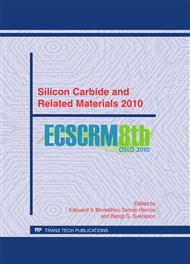[1]
R. T. Leonard, Y. Khlebnikov, A. R. Powell, C. Basceri, M. F. Brady, I. Knlebnikov, J. R. Jenny, D. P. Malta, M. J. Paisley, V. F. Tsvetkov, R. Zilli, E. Deyneka, H. McD. Hobgood, V. Balakrishna, and C. H. Carter, Jr.: Mater. Sci. Forum Vol. 600-603 (2009).
DOI: 10.4028/www.scientific.net/msf.600-603.7
Google Scholar
[2]
M. Tajima, E. Higashi, T. Hayashi, H. Kinoshita, and H. Shiomi: Appl. Phys. Lett. Vol. 86 (2005), p.061914.
Google Scholar
[3]
K. X. Liu, X. Zhang, R. E. Stahlbush, M. Skowronski, and J. D. Caldwell: Mater. Sci. Forum Vol 600-603 (2009), p.345.
Google Scholar
[4]
I. Kamata, H. Tsuchida, T. Miyanagi, and T. Nakamura: Mater. Sci. Forum Vol. 527-529 (2006), p.415.
Google Scholar
[5]
R. E. Stahlbush, B. L. VanMil, R. L. Myers-Ward, K-K. Lew, D. K. Gaskill, and C. R. Eddy: Appl. Phys. Lett. Vol. 94 (2009), p.041916.
DOI: 10.1063/1.3070530
Google Scholar
[6]
T. Kimoto, S. Nakazawa, K. Hashimoto, and H. Matsunami: Appl. Phys. Lett. Vol. 79 (2001), p.2761.
Google Scholar
[7]
G. Feng, J. Suda, and T. Kimoto: Appl. Phys. Lett. Vol. 92 (2008), p.221906.
Google Scholar
[8]
J. Hassan and J. P. Bergman: J. Appl. Phys. Vol. 105 (2009), p.123518.
Google Scholar
[9]
T. Dalibor, G. Pensl, H. Matsunami, T. Kimoto, W. J. Choyke, A. Schӧner and N. Nordell: Phys. Status Solidi A Vol. 162 (1997), p.199.
DOI: 10.1002/1521-396x(199707)162:1<199::aid-pssa199>3.0.co;2-0
Google Scholar
[10]
C. Hemmingsson, N. T. Son, O. Kordina, J. P. Bergman, E. Janzén, J. L. Lindstrӧm, S. Savage, and N. Nordell: J. Appl. Phys. Vol. 81 (1997), p.6155.
DOI: 10.1063/1.364397
Google Scholar
[11]
P. B. Klein: J. Appl. Phys. Vol. 103 (2008), p.033702.
Google Scholar
[12]
T. Kimoto, K. Danno, and J. Suda: Phys. Status Solidi (b) Vol. 245 (2008), p.1327.
Google Scholar
[13]
S. A. Reshanov, G. Pensl, K. Danno, T. Kimoto, S. Hishiki, T. Ohshima, Fei Yan, R. P. Devaty, and W. J. Choyke: Mater. Sci. Forum Vol. 600-603 (2009), p.417.
DOI: 10.4028/www.scientific.net/msf.600-603.417
Google Scholar
[14]
K. Danno, D. Nakamura, and T. Kimoto: Appl. Phys. Lett. Vol. 90 (2007), p.202109.
Google Scholar


